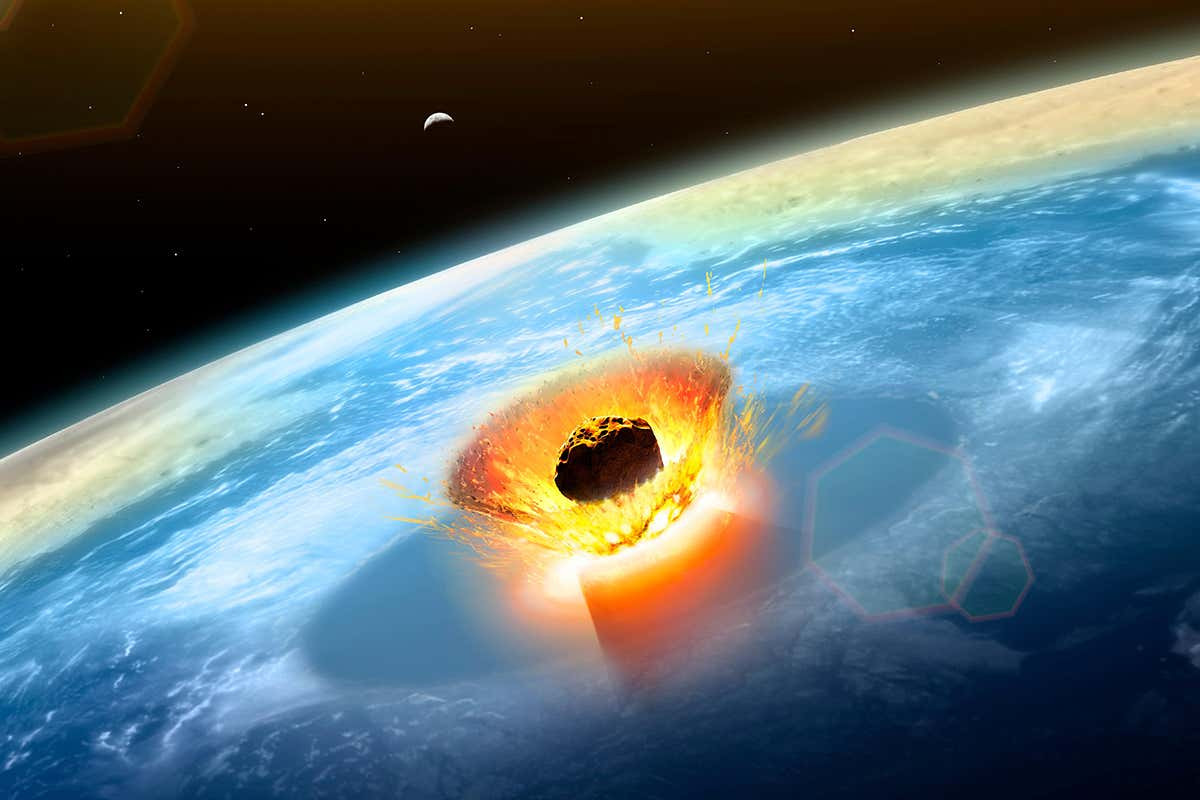Sixty-six million years ago, a cataclysmic event reshaped the course of life on Earth, leading to the extinction of the dinosaurs and paving the way for the rise of mammals. This event was triggered by a massive asteroid colliding with our planet. But where exactly did this dinosaur-killing asteroid hit? The answer lies beneath the Yucatán Peninsula in Mexico, marked by a colossal impact crater known as Chicxulub.
 Illustration of a large asteroid colliding with Earth on the Yucatan Peninsula, forming the Chicxulub crater
Illustration of a large asteroid colliding with Earth on the Yucatan Peninsula, forming the Chicxulub crater
The Chicxulub impact event, depicting a large asteroid striking the Yucatan Peninsula, resulting in the formation of the Chicxulub crater and widespread environmental devastation.
The Devastating Chicxulub Impactor
Dubbed the Chicxulub impactor, this space rock was no pebble. Estimated to be between 10 and 15 kilometers in diameter – comparable in size to a city – it struck Earth with incredible force at a velocity of 20 kilometers per second. The angle of impact, calculated at approximately 60 degrees from the horizontal, was particularly devastating as it maximized the amount of vaporized rock and debris propelled into the atmosphere.
The immediate consequences of this collision were apocalyptic. The impact instantly vaporized rock and sent colossal plumes of debris high into the atmosphere. Rocks from deep within the Earth’s crust were ejected as high as 25 kilometers, and a towering ring of mountains, surpassing the height of the Himalayas, surged up around the newly formed crater’s rim.
[ Ichthyosaur
Ichthyosaur
Fossil of a large Ichthyosaur, an extinct marine reptile, highlighting discoveries of even larger Triassic super-predators that lived around the time of the Chicxulub impact.
Chicxulub Crater: Ground Zero of the Extinction Event
The impact site, now known as the Chicxulub crater, is centered just off the coast of the Yucatán Peninsula. The name “Chicxulub” itself comes from a small Mayan town located near the crater’s center. Spanning over 150 kilometers in width, the crater is a massive scar on the Earth’s crust, buried beneath layers of sediment.
Scientists working for Pemex, the Mexican state oil company, first detected the Chicxulub crater in the 1960s through geophysical surveys. However, it wasn’t until the 1990s that the definitive link between this massive geological structure and the Cretaceous-Paleogene extinction event was established. This connection revolutionized our understanding of dinosaur extinction and Earth’s history.
[
Dust cloud blocking the sun, illustrating the impact winter caused by the Chicxulub asteroid strike and its role in the dinosaur extinction event.
Global Consequences and the Dinosaur Extinction
The Chicxulub impact unleashed a cascade of global environmental disasters. Vast quantities of sulfur-based gases and fine silicate dust were ejected into the stratosphere, enshrouding the planet in a thick haze. This atmospheric veil blocked sunlight, triggering a prolonged “impact winter” that may have lasted for as long as 15 years.
This drastic reduction in sunlight caused global temperatures to plummet, disrupting plant photosynthesis and collapsing food chains. For dinosaurs, who had dominated terrestrial ecosystems for nearly 200 million years, and countless other species, these abrupt and devastating environmental changes proved insurmountable. The Chicxulub impact is now widely accepted as the primary cause of the Cretaceous-Paleogene extinction event, the mass extinction that wiped out the non-avian dinosaurs and dramatically altered the course of life on Earth.
While some aspects of the dinosaur extinction event and the Chicxulub impact are still subjects of ongoing research and debate, the location of the asteroid’s impact – the Chicxulub crater in the Yucatán Peninsula – is firmly established as ground zero for this pivotal moment in Earth’s history.
